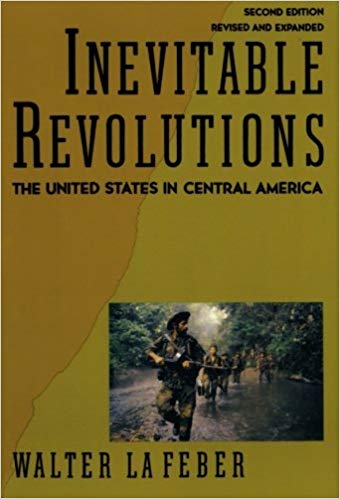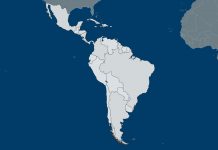Inevitable Revolutions: The United States in Central America
By Walter LaFeber
George Washington was elected president of the United States in 1789, but it would be more than 100 years before a sitting U.S. head of state ventured outside his country’s borders for a diplomatic visit. That it was Teddy Roosevelt should come as no surprise, given his carefully curated reputation as a khaki-clad Man of the World. That his destination was Central America, however, seems counterintuitive. He could have gone to the United Kingdom, a country with which the U.S. had tangled since before it was even the U.S. He could have gone to Spain, against which the United States had just won a war that (we now know) paved the way for U.S. dominance for decades to come. He could have gone to visit any great power, but he didn’t. He went to Panama – to observe the progress of the Panama Canal, a symbol of U.S. geopolitical strength and, in time, a major contributor to it.
Roosevelt’s stewardship of the Panama Canal is well-known. But the U.S. was interested in the region, and in the prospects of an isthmian canal there, long before he became president. Thomas Jefferson wrote about the importance of Central America as early as the 1780s. He considered it a natural extension of the new American domain, the southern reach of what expansionists in the U.S. would later call Manifest Destiny.
If you’re a Founding Father, the sense of stewardship is only natural. As Walter LaFeber writes in “Inevitable Revolutions,” his excellent account of U.S.-Central American affairs, Washington, D.C., is closer to El Salvador than it is to San Francisco. Early leaders understood how the region could unlock their country’s trade potential. And, indeed, by the 1980s, when the book was first published, more than “two-thirds of all U.S. trade and the nation’s oil imports, as well as many strategic minerals, depend[ed] on the Caribbean sea lanes bordered by the five Central American nations.” (Such strategic considerations also touch on the United States’ obsession with Cuba.)
Which is to say that the canal’s construction was not the reason the U.S. was interested in Central America, or why it became powerful there. Its interest and power there were the reasons the canal was built.
There’s plenty more to say about U.S. interests beyond the canal – in fact, LaFeber doesn’t dwell on the canal for very long – but focusing solely on those ignores the moral context of the region’s modern history. And here is where LaFeber excels. Because U.S. leaders identified the strategic value of Central America early on, the region quickly became a target of Washington’s imperial ambitions. First came the Monroe Doctrine, which, however toothless it was initially, laid the foundation for subsequent policies with much more bite. The Roosevelt Corollary, Taft’s dollar diplomacy, Wilson’s declaration on Latin America, the Good Neighbor Policy – each policy in its unique way advanced U.S. interests while subverting Central American interests. It was a zero-sum game that the U.S. never really lost.
Through these policies, the United States tethered Central American nations to its own prerogatives. Once Washington solidified its position over the British and Germans, these countries became single-crop agrarian economies that depended almost entirely on U.S. markets. They received loans from Wall Street and Washington and from no one else. They imported most of their food from the U.S. And when anything compromised U.S. interests – like when a democratically elected leader wanted to tip the scales away from the oligarchs that were the instruments of Washington’s policies – the U.S. would either support local insurrections against them or simply intervene directly. As time went on, Washington would opt for the former over the latter, but early on, as LaFeber notes, between 1898 and 1920, U.S. Marines entered the Caribbean region no fewer than 20 times.
The case of Honduras was especially instructive. In LaFeber’s words, the country was “less a nation than a customs house surrounded by adventurers.” Northern Honduras was effectively annexed to foreign corporate interests. Enterprising banana companies arrived around 1900, bought up the best tracts of land, built their own railroads, established their own banking systems and capitalized on the corruption of local government officials. The owners declined to share with the rest of Honduras the fruits of their prosperity.
After so many similar situations played out throughout the region, it’s little wonder that LaFeber regards the revolutions that ensued as inevitable. He writes: “Unable to deal with the products of its own system, reconcile the contradiction between its professed ideals and its century-old foreign policy, or work with other nations to resolve these dilemmas, the United States … has resorted to force.” Students of geopolitics know that the use of force often begets more force. Uprisings, then, were not incidental to the system that created and governed Central America; they were a consequence of it. The system was instrumental in making the United States the power it is today. Yet that power came at a cost – not just to the Central American nations that suffered the system, but also to the superpower that still has to deal with its repercussions.
Cole Altom, managing editor
Donbass and Civilians
By the Rinat Akhmetov Foundation Humanitarian Center
More than three years after the signing of the Minsk accords, the conflict in Ukraine’s Donbass region is still frozen. But the Rinat Akhmetov Humanitarian Center is working to make sure that it isn’t forgotten. In the photobook “Donbass and Civilians,” the center attempts to show the world how ordinary citizens there have been living through armed conflict for nearly five years. The book, released earlier this year, contains 11 stories of civilians in Donbass who have suffered from the hostilities playing out around them. They are people, mainly children and the elderly, from Kramatorsk, Antratsyt, Avdiyivka and Donetsk – the towns and cities at the epicenter of the war – and each one tells a true story of life during wartime. These are tales of hunger, fear and death, the products of the war in Donbass.
The book’s publisher is itself a product of the war. The Rinat Akhmetov Foundation established its Humanitarian Center in August 2014 – nearly halfway through the first year of the conflict – to help the civilians living in the breakaway regions of Donetsk and Luhansk who were affected by the hostilities. Today, the Rinat Akhmetov Foundation is the largest humanitarian mission in Ukraine, and its goal is to raise awareness of the situation in Donbass in Ukraine and abroad. “Donbass and Civilians” is just one example of this work. Though few print copies exist, the foundation has made the book available at its website, with the hope of drawing eyes, and perhaps humanitarian assistance, from around the world. It has also presented “Donbass and Civilians” in Kiev, Mariupol and Frankfurt, as well as in Brussels, where it debuted at the annual conference of the European Foundation Center before representatives of the United Nations and other international organizations.
When discussing a book that documents the miserable realities of war, I find it hard to justify giving my opinion. It simply seems irrelevant for a work like “Donbass and Civilians,” which is bound to evoke different emotions in different readers. I will say, though, that the book accomplishes what no other coverage of the war in Donbass has: It offers insight into how people actually live in the conflict zone. And plenty of people do, most of them women, children and retirees surviving below the poverty line, largely on social benefits and humanitarian aid. Many of these people are still at risk of being wounded or killed. According to the United Nations, more than 3,000 civilians were killed in the Donbass from April 2014 to August 2018. So long as the war continues, the death toll will keep growing.
Ekaterina Zolotova, analyst







 The Geopolitics of the American President
The Geopolitics of the American President